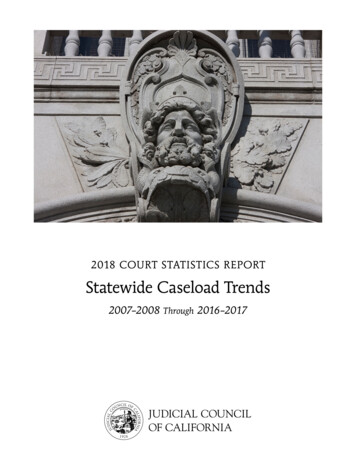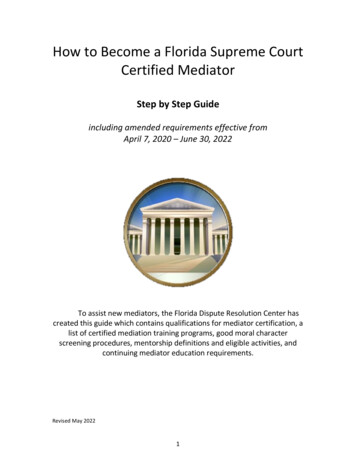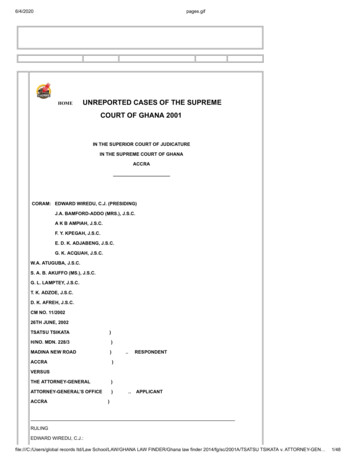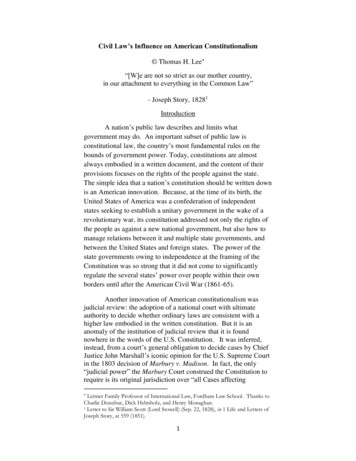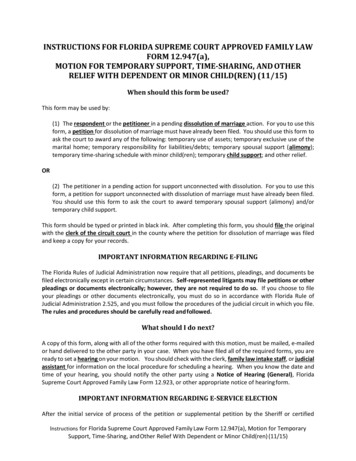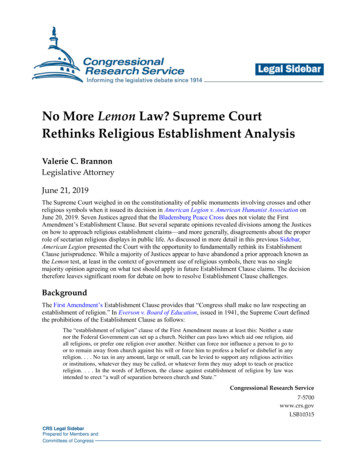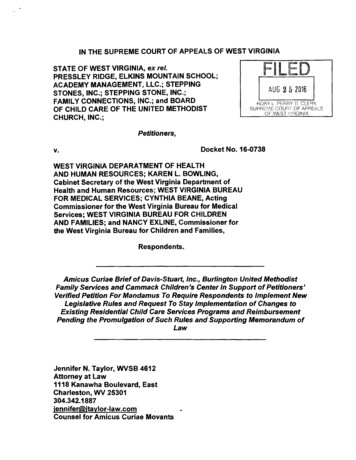
Transcription
IN THE SUPREME COURT OF APPEALS OF WEST VIRGINIASTATE OF WEST VIRGINIA, ex rei.PRESSLEY RIDGE, ELKINS MOUNTAIN SCHOOL;ACADEMY MANAGEMENT, LLC.; STEPPINGSTONES, INC.; STEPPING STONE, INC.;FAMILY CONNECTIONS, INC.; and BOARDOF CHILD CARE OF THE UNITED METHODISTCHURCH, INC.;FilEIAUG 25 l016RORY L. PERRY It CLERKSUPREME COLJRl OF APPEALSOF \ vEST \j!nGlr IAPetitioners,v.Docket No. 16-0738WEST VIRGINIA DEPARATMENT OF HEALTHAND HUMAN RESOURCES; KAREN L. BOWLING,Cabinet Secretary of the West Virginia Department ofHealth and Human Resources; WEST VIRGINIA BUREAUFOR MEDICAL SERVICES; CYNTHIA BEANE, ActingCommissioner for the West Virginia Bureau for MedicalServices; WEST VIRGINIA BUREAU FOR CHILDRENAND FAMILIES; and NANCY EXLINE, Commissioner forthe West Virginia Bureau for Children and Families,Respondents.Amicus Curiae Brief of Davis-Stuarl, Inc., Burlington United MethodistFamily Services and Cammack Children's Center In Support of Petitioners'Verified Petition For Mandamus To Require Respondents to Implement NewLegislative Rules and Request To Stay Implementation of Changes toExisting Residential Child Care Services Programs and ReimbursementPending the Promulgation of Such Rules and Supporting Memorandum ofLawJennifer N. Taylor, WVSB 4612Attorney at Law1118 Kanawha Boulevard, EastCharleston, WV 25301304.342.1887jennifer@jtaylor-Iaw.comCounsel for Amicus Curiae Movants
TABLE OF CONTENTSTABLE OF AUTHORITIES . iiINTRODUCTION . 1INTEREST, IDENTITY AND AUTHORITy. 2ARGUMENT . 10I.Standard of Relief. . 10II.The Respondents Have a Legal Duty to Promulgate LegislativeRules. 10III.The Respondents Have a Duty to Promulgate Rules that Take IntoConsideration the Specialized Needs of Children and the SpecializedServices Offered by the Movants . . 12IV. The Movants Have a Clear Legal Right to Negotiate ProviderAgreements Without Threats or Duress. . 16V.The Movants Have a Clear Legal Right to Maintain the Status QuoWhile the Respondent Properly Promulgates Legislative Rules. 21VI.The Respondents Have a Legal Duty to Prevent the Loss of FederalMatching Funds That Would Be Lost Under the New ProviderAgreements. 23VII.Conclusion . 24VERIFiCATION . 26CERTIFICATE OF SERViCE . 27
TABLE OF AUTHORITIESCASESArt's Flower Shop, Inc. v. Chesapeake and Potomac Tel. Co. of W Va., Inc., 186W.va. 613,413 S.E.2d 670 (1991) . 18Bd. of Ed. of the County of Berkeley v. W. Harley Miller, Inc., 160 W.va. 473, 236S.E.2d 439 . 18Brown v. Genesis Healthcare Corp., 228 W.Va. 646, 724 S.E.2d 250 (2011) . 17,19Brown v. Genesis Healthcare Corp., 229 W.Va. 382, 729 S.E.2d 217 (2012) . 17,18Dan Ryan Builders, Inc. v. Nelson, 230 W.va. 281, 737 S.E.2d 550 (2012) . 18Pingley v. Perfection Plus Turbo-Dry, LLC, 746 S.E.2d 544, 231 W. Va. 553(W.Va., 2013 . 19Potomac Edison Co. v. Jefferson County Planning & Zoning Comm'n, 204 W. Va.319,512 S.E.2d 576 (1998) . 10State ex rei McLaughlin v. W. Va. Court of Claims, 209 W.va. 412, 549 S.E. 2d286 (2001.) . 10State ex rei. Brown v. Corporation of Bolivar, 217 W.va. 72, 614 S.E.2d 719(2005) . 10State ex reI. Clites v. Clawges, 685 S.E.2d 693, 224 W.va. 299, 306 (2009) . 17State ex reI. Dickerson v. City of Logan, 221 W.va. 1,650 S.E.2d 100 (2006.) 10State ex rei. Kucera v. City of Wheeling, 153 W.Va. 538,170 S.E.2d 367 (1969). 10Walter v. Ritchie, 156 W. Va. 98, 191 S.E.2d 275 (1972) . 10STATUTESW Va. Code § 29A-1-1 . 11RULESW. Va. Code of State Rules §78-3-1 . 4Rule 30, W. Va. Rules of Appellate Procedure . . 1OTHER AUTHORITIESThe Juvenile Justice Commission's Findings of Fact and RecommendationsRelating to DHHR's Proposed Contract Changes for the Placement of WestVirginia Youth . 6, 7, 9, 11, 13 16ii
INTRODUCTIONThe Movants, Davis-Stuart, Inc., Burlington United Methodist FamilyServices and Cammack Children's Center respectfully submit their amicus curiaebrief in support of the "Verified Petition For Mandamus To Require Respondentsto Implement New Legislative Rules and Request To Stay Implementation ofChanges to Existing Residential Child Care Services Programs andReimbursement Pending the Promulgation of Such Rules" submitted by thePetitioners Pressley Ridge, Elkins Mountain School, Academy Management,LLC, Stepping Stones, Inc., Stepping Stones, Inc., Family Connections, Inc. andBoard of Child Care of the United Methodist Church, Inc. 1Pursuant to the provisions of Rule 30 of the W. Va. Rules of AppellateProcedure, notice of the Movants' intent to file an amicus curiae brief wasprovided by letter e-mailed and mailed by United States Mail, postage pre-paid,upon counsel for the Respondents and counsel then of record on Thursday,August 18, 2016. A copy of said letter is attached hereto as Exhibit No.1 in theAppendix. As of this filing, the Movants herein have not had a response from theRespondents or their counsel.Pursuant to the provisions of Rule 30(e)(5) of the W. Va. Rules of Appellate Procedures, the Movants,Davis-Stuart, Inc., Burlington United Methodist Family Services and Cammack Children's Center state thatno party's counsel authored this brief in whole or in pan; no party or party's counsel contributed money thatwas intended to fund preparing or submitting this brief; and all funding for this brief was provided solely bythe amicus curiae Movants herein.11
INTEREST, IDENTITY AND AUTHORITYPursuant to the provisions of Rule 30(e)(4) of the W. Va. Rules ofAppellate Procedures, your amicus curiae Movants state the each of them is afacility identical to that of the Petitioners - a licensed, not-for-profit, groupresidential child care facility that serves the needs of children throughout thestate of West Virginia.Davis-Stuart, Inc. {"Davis-Stuart") is a group residential child care facilitythat has operated for almost 100 years in Lewisburg, West Virginia, inpartnership with the Presbyterian Church, U.S.A. Davis-Stuart has a total of 68beds available for the treatment of youth. The main campus in Lewisburgprovides beds for 44 residents, while each of four group homes in Bluefield,Princeton, Beckley and Maxwelton provide for six (6) residents respectively. TheLewisburg Campus is considered Level II. The community based group homesare designated Levell. Davis-Stuart serves approximately 150 youth and theirfamilies each year. The Movant employs 120 people and hosts a West VirginiaDepartment of Education School on the main campus in Lewisburg that providesa full service educational component. Davis-Stuart offers several uniqueprograms on its main campus, such as an equine assisted therapy program, anemployment preparation program, a culinary arts program shared with the WestVirginia Department of Education, and a Spiritual Life program. The MercerCounty Group Homes work very closely in conjunction with 9th Judicial Circuit inserving many youths involved in the Drug Court and enabling those who must be2
removed from their respective homes to stay in the community, participate indrug court and attend their school of origin.Burlington United Methodist Family Services ("Burlington") is a groupresidential child care facility headquartered in Charleston, West Virginia.Burlington has also provided residential child care services for over 100 years.Between its main facility and its Beckley operations, Burlington has a total of 91beds. The Beckley facility generally serves ten (10) Level II children 12 to 18years of age, and twenty (20) Level III children in that age group. The facility inCharleston hosts children eight to 18 years old and is segregated by age, whichrequires more staff. Currently the Charleston facility hosts 14 Level II childrenand 20 Level III children. Both the Beckley and Charleston facilities have on ground schools staffed by teachers provided by the West Virginia Department ofJuvenile Services. Teacher's aides are direct Burlington employees. The Danielsfacility currently hosts eight (8) children who have been diagnosed with a Level IIIco-existing disorder. These children require more intense supervision. The OldFields facility also serves children with a Level III co-existing disorder, ages five(5) to 10 years of age, who also require more intense supervision. Thesechildren attend on-ground school and are bussed 12 miles each way byBurlington staff. The Keyser Transitional Living facility has five (5) Phase Ichildren and four (4) Phase II children. Phase I children require moresupervision. All programs have a Spiritual Life component that is funded by theMethodist Church and donations.3
Cammack Children's Center ("Cammack") is a group residential childcare facility located in Huntington, West Virginia that has served families in WestVirginia since 1914. Cammack is a Level II therapeutic group home with anintensive professional multi-disciplinary focus for adolescents who are in need ofa residential setting. The Movant provides a structured and alternative livingsituation for both male and female youth between the ages of 12 through 17 whoare in the custody of the West Virginia Department of Health and HumanResources. Cammack provides individual and group therapy for children, familytherapy, supportive counseling on an individual or group basis, and behaviormanagement. The facility currently has 32 co-ed beds. Cammack has an on grounds school that provides credit recovery with transition to public schools. Italso offers summer school, a recreational facility and a 24-hour on-call on-sitenursing staff.Like the original Petitioners, each Movant herein is duly licensed as agroup residential facility pursuant to the provisions of W Va. Code § 49-2-113and W Va. Code of State Rules §78-3-1. They each provide services to childrenwith varying ranges of emotional and behavioral issues. For decades, eachMovant has been a signatory to provider agreements with the West VirginiaDepartment of Health and Human Resources ("DHHR") Bureau for Children andFamilies ("BCF") and the Bureau for Medical Services ("BMS"). The Movantsalso receive significant private funding from other sources, including thePresbyterian Church U.S.A and the United Methodist Church.4
The BMS is responsible for oversight and implementation of the Medicaidprogram in West Virginia. Under prior agreements, the BMS and BCF reimbursedresidential child care providers for four components of services under a "bundledrate" system.That payment system varied based upon the level of servicesprovided (Level I, II, or III) under Appendix F to Chapter 503 of the West VirginiaMedicaid Provider Manual. For room, board, and supervision the providers werepaid from state dollars through BCF. For services that fell into the "treatment"category, providers were paid through BMS and were subject to the 3-to-1Medicaid match from the federal government.In July 2016, the Respondents presented the providers of residential childcare services in this state with new contracts.Under the new agreements,reimbursement for the four components would be transitioned into what amountsto a fee-for-service system. The providers would be reimbursed for traditionalservices, such as room and board, counseling and medical services, as recognizedby the Medicaid manual. However, some specialized services, such as the equineassisted therapy program, employment preparation program, culinary artsprogram and the extensive nursing services offered by Davis-Stuart, did not fallinto the traditional categories recognized by the Medicaid program. Consequently,the specialized services offered by the Movants would not be subject toreimbursement; the children would be deprived of these highly successfulprograms; and the providers would suffer significant financial harm.The new provider agreements were also drafted without any basis in rule orlaw. The previous agreements were sul5ject to the provisions of legislative rules,5
which included standards, guidelines and enforcement authority approved by theWest Virginia Legislature. However, BCF and BMS failed and refused to developor promulgate any new rules that reflect the procedures and reimbursementschedules contained in the new provider agreements.The Respondentscircumvented their clear legal duty to appropriately promulgate the anticipatedchanges to the programs and reimbursement methodologies for group residentialfacilities. As a result, both the Movants and the Respondents themselves werewithout clear direction on how to proceed.The entire contractual arrangement proposed by the Respondents wasbased on arbitrary, internal policies that could be changed at any time and werenot subject to legislative review or approval. The intentional protections offered bya legislatively-approved rule were brushed aside in favor of an ever-changing,arbitrary system that lacked the governmental oversight inherent in the staterulemaking procedures.The Movants, the Petitioners and other parties protested the terms of thenew agreements and asked the Respondents if the parties could discuss theissues. The Respondents agreed, and appeared to be engaged in negotiationswith all of the stakeholders. However, the Respondents ultimately backed offfrom the negotiations and insisted that all providers sign the new agreements orface immediate termination of all contracts. Quite simply, the Respondentsrequired the Movants to sign unconscionable contracts of adhesion.As noted by the Juvenile Justice Commission, the new provideragreements and the proposed operation'al changes were "a unilateral attempt,6
under the guise of contract negotiations, to make systemic changes to the careand treatment of West Virginia children." The Juvenile Justice Commission'sFindings of Fact and Recommendations Relating to DHHR's Proposed ContractChanges for the Placement of West Virginia Youth, August 22, 2016, p. 3,("Juvenile Justice Commission Findings"), Appendix, Exhibit No.2.During this period, the Respondents also submitted an amendment to theState Health Plan to the Centers for Medicare and Medicaid Services, againwithout promulgating new legislative rules that would offer operational standardsand instruction. This amendment would substantially change the state'sMedicaid plan and directly affect the reimbursement provisions for child careproviders. These changes were not made in collaboration with any of theaffected stakeholders; were not enacted through legislation or standardrulemaking procedures, and are contrary to the progress West Virginia has madein terms of appropriate child placement.The Respondents proposed instead, to use internal policies that wouldserve as "guidelines" - policies that are vague, contradictory, and void of anyactual direction or legislative oversight. The policies do not state how to bill forthe unbundled services or even what to bill. They do not recognize the varyingtreatment levels for children, or the unique programs offered by many providersthat are not necessarily included in standard reimbursement formulas. Some ofthe contract terms and the guidelines are at odds with each other, and withcurrent law.7
The shift from legislatively-approved rules to vague, internal guidelinessignificantly affects the reimbursement rates to the providers of group residentialchild care services, place children at risk of placement in more restrictivesettings, and would increase the number of out of state placements or childrenwho receive no services at all. The agency charged with the health and humanservices of this state has failed in its duty to safeguard either one.Davis-Stuart, Burlington and Cammack signed the new agreements, underprotest and under duress. Davis-Stuart and Burlington recognized that as faith based providers, their moral commitment to the children of West Virginia faroutweighed the possible and probable financial distress that would result fromthe new provider agreements. Each of the Movants chose to continue servingthe children of this state - notwithstanding the possible illegality of the newagreements, the probable financial losses and the general mass confusionsurrounding the process - instead of risking immediate closure and the certaintyof a loss of services to their vulnerable clients.The Movants are directly and detrimentally affected by the significant andarbitrary changes proposed by the Respondents through the provideragreements. They stand to lose significant portions of their budgets, and have nomeans of recouping their losses. Three well-established residential child careproviders that have operated in the State of West Virginia for over a century nowface closure if the Respondents are permitted to continue acting in a reckless,irresponsible and illegal manner.8
The children of this state also face irreparable harm if the Respondentsare permitted to continue on this road to chaos and confusion. Without thespecialized residential services provided by the Movants the number of out-of state placements would increase, and children would be placed in morerestrictive environments. West Virginia has fought against both of these issuesfor over three decades, and in one single move the Respondents would causethe state to regress backwards instead of progressing forward when it comes tothe care of its youngest and most vulnerable citizens.The West Virginia Juvenile Justice Commission issued findings of fact andrecommendations on August 22,2016, and specifically found that not only werethe Respondent's proposed changes "cloaked in secrecy," they could indeed bedetrimental to the state's network of shelter and residential placements. "WestVirginia Juvenile Justice Commission's Findings of Fact and RecommendationsRelating to DHHR's Proposed Contract Changes for the Placement of WestVirginia Youth," August 22,2016, p. 6, Appendix Exhibit No.2.These findings cannot be ignored. The submission of a new amendmentto the State Health Plan without the underlying, required state rules, theinsistence on contracts of adhesion that likewise have no basis in rule or lawreflect a department in disarray, with no sense of responsibility towards either theproviders in this state or the children.As such, the Movants join with the Petitioners in their Writ of Mandamusand pray that this Court require the Respondents to act according to the law andnot by their own arbitrary standardsthat-circumvent the same.9
ARGUMENTI.Standard of Relief.Three elements must be present in order for this Court to issue a writ ofmandamus: The parties must establish "(1) a clear legal right in the petitioner tothe relief sought; (2) a legal duty on the part of the respondent to do the thingwhich the petitioner seeks to compel; and (3) the absence of another adequateremedy." Syl. Pt. 2, State ex rei. Kucera v. City of Wheeling, 153 W.Va. 538, 170S.E.2d 367 (1969); Syl. Pt. 1, State ex rei. Brown v. Corporation of Bolivar, 217W.va. 72, 614 S.E.2d 719 (2005); Syl. Pt. 1, State ex rei. Dickerson v. City ofLogan, 221 W.Va. 1,650 S.E.2d 100 (2006.)A writ of mandamus is entirely appropriate in order to require theperformance of a non-discretionary duty by a governmental agency or body. Syl.Pt. 2, State ex rei McLaughlin v. W. Va. Court of Claims, 209 W.Va. 412, 549 S.E.2d 286 (2001.) By granting a writ of mandamus, the Court may compel anadministrative officer to perform a nondiscretionary duty where it appears that theofficial refuses to recognize the nature and scope of his or her duty and proceedson the belief of entitlement in the discretion to do or not to do the thing demandedby law. See, e.g., Walterv. Ritchie, 156 W. Va. 98,191 S.E.2d 275 (1972);Potomac Edison Co. v. Jefferson County Planning & Zoning Comm'n, 204 W. Va.319,512 S.E.2d 576 (1998).II.The Respondents Have a Legal Duty to Promulgate LegislativeRules.The Movants support the. writ of Il]andamus filed by the Petitioners askingthis Court to require the Respondents to promulgate new legislative rules before10
seeking approval of the amendment to the State Health Plan, implementingoperational changes or requiring all providers to sign the new agreements. Asnoted by the Petitioners and other amicus curiae, the West VirginiaAdministrative Procedures Act, W. Va. Code § 29A-1-1, et seq. requires theRespondents to submit legislative rules; to give all stakeholders interested oraffected by the rules the opportunity to comment and participate in thepromulgation of the same; and to obtain specific legislative approval of thoserules.As noted by this Court's own Juvenile Justice Commission, theRespondents completely circumvented the rulemaking process and resorted todictatorial tactics that ignore the basic purpose behind the AdministrativeProcedures Act. Rather than repeat the arguments of the Petitioners and otheramicus curiae on this issue, the Movants simply state that they agree with theposition of these parties, incorporate their arguments herein, and pray that thisCourt find that the failure of the Respondents to promulgate proper legislativerules prior to requiring the proposed changes is a dereliction of their clear legalduty to the providers and children of this state.The Respondents should be required to recall the new State Health Planamendment submitted for federal approval; to promulgate legislative rules usingthe rule-making process that protects the interests of state agencies and allstakeholders involved; to perform the studies and analyses as recommended bythe Juvenile Justice Commission, and to perform such other acts as the Courtdeems reasonable and necessary unde(the circumstances.11
III.The Respondents Have a Duty to Promulgate Rules that Take IntoConsideration the Specialized Needs of Children and theSpecialized Services Offered by the Movants.The rules that the Respondents should have promulgated - and hopefullywill be required to promulgate - must reflect the varying needs of children whoare placed in group residential care homes, as well as the different and uniquespecialized services that the Movants provide. Neither children nor residentialchild care providers fit into the pre-determined molds proposed by theRespondents. The failure to recognize the distinctive needs of the children, aswell as the unconventional but successful services of the providers, results inserious and detrimental harm to everyone involved.West Virginia has spent many years developing legislation andparticipating in extensive and decades-long litigation focused on the placement ofchildren in residential care facilities. The ultimate goals are to place a child in theleast restrictive environment, in a West Virginia facility that appropriately ensuresthe safety of that child and others around him or her, and to develop collaborationamong all interested and affected parties as to the most appropriate placementand treatment for the child. Those parties consist of judges, multidisciplinaryteams, providers, professionals and para-professionals from multiple areas and,of course, the parents and children themselves.The new policies proposed by the Respondents are contrary to the long term goals that the Legislature, the courts and advocates of children have workso hard to obtain. The Respondents' proposed policies and procedures fail torecognize the individual needs of children in need of residential care programs12
and completely disregard the concepts of judicial discretion andrecommendations from multidisciplinary teams. The mysterious computerizedmatrix - which no one has ever seen - supposedly selects placement of the childaccording to arbitrary standards that do not consider court findings, therecommendations from multidisciplinary teams or even the ability of the providerto appropriately treat the child. 2 Such a system is a disaster waiting to happen.Just as children differ, so do child care providers differ. The obviousdistinction among the providers embroiled in this proceeding is emergency childcare shelters, which do not provide the same services as residential treatmentfacilities. The residential child care providers have significantly more beds, andprovide a full range of varying, often specialized services to children with multiplelevels of needs. Yet, the policy propounded by the Respondents intends to treatall providers alike, regardless of the level of services or care.Under the previous system, all parties were bound by specific rules thatrecognized the ever-changing needs of the children and the different levels ofservices provided by the facilities. W Va. C.S.R. §78-3-1,et seq., providedguidance and direction for both the agencies and the facilities regarding thedelivery of residential child care services. The rules established requirements foroperating facilities; hiring and training of staff; credentialing professionals andemployees; oversight, supervision, and reporting; procedures for intake,treatment planning and discharge. They recognized the varying levels of need2Juvenile Justice Commission Findings, p. 4.13
and treatment as reflected in the classification of a child as either Levell, Level IIor Level 111. 3Traditionally, the DHHR paid providers for the cost of all room, board andsupervision expenses out of state funds. These costs were paid through theBCF and subject to a ceiling or cap established by DHHR. Any expenses inexcess of the cap were deemed residual costs, and paid out of Medicaid fundsthrough BMS, which, in turn were subject to the federaI3-to-1 match. These twofunding sources were combined to establish a "bundled" per diem rate for theprovider.4Under the new system, providers will receive one standard level ofreimbursement, regardless of the level of services provided. BCF proposes toreimburse residential child care providers for room, board and supervisionservices based upon new daily rates for either "standard" or "enhanced" services.However, the new internal policies that purportedly supersede W.va. C.S.R. §78 3-1 ,et seq., fail to define the terms "standard" or "enhanced" services, anddisregard the fact that there are varying levels of needs on the part of thechildren and varying levels of services as provided by the facilities.Level III reflects a child in need of the highest level of specialized care A facility that normallyserves a Level I or Level II group of children often does not have the skilled professionals neededto serve an acute Level III child. A facility that does have the specially-trained staff to treat ahigh-acuity Level III child will, naturally, have more specialized treatment programs and highercosts.3Davis-Stuart has residual costs in the form of its equestrian, culinary arts and employmentpreparation programs. These specialized services are different; they do not neatly fall into a pre determined category and are not easily che.cked.off as standard residential treatment. Davis Stuart has a 5.4 million annual budget, and under the DHHR's proposed plan the agency willexperience a 950,000 deficit. These specialized programs will not be sustainable.414
Not only do the new policies fail to recognize the varying needs of thechildren, they also fail to recognize - and pay for - the specialized servicesoffered by many child care providers, including the Movants herein. The originalMedicaid Manual, on which the Respondents intend to rely, was written foroutpatient treatment, not group residential programs that offer specializedservices. Moreover, the codes for billing in a residential facility environment arewoefully insufficient, especially in light of the additional service requirements thatthe Respondents have imposed upon the providers. 5The amendment to the State Health Plan and the Medicaid Manual shouldbe re-written to recognize that children have varying needs and that fee-for service reimbursement rates cannot possibly cover all treatment servicesprovided, whether standard or specialized. The basic room, board andsupervisions rates should also be adjusted in order to cover the additionalsupervision requirements now imposed by the Respondents. All of thesechanges require a meeting of the minds, coordination and cooperation of bothagencies and stakeholders and, m
LLC, Stepping Stones, Inc., Stepping Stones, Inc., Family Connections, Inc. and . Cammack Children's Center ("Cammack") is a group residential child care facility located in Huntington, West Virginia that has served families in West . grounds school that provides credit recovery with transition to public schools. It


